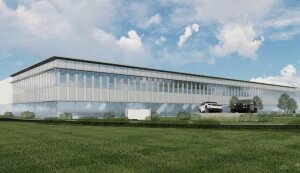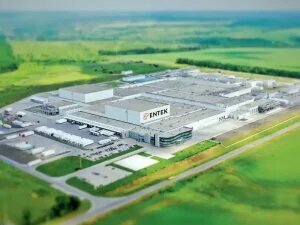Kokomo Gigafactory, $2.5B
 Image from Stellantis.
Image from Stellantis.Partnering companies Stellantis N.V. and Samsung SDI have big plans for Indiana. The duo plans to invest more than $2.5 billion and create 1,400 new jobs in Kokomo and the surrounding areas.
Stellantis is an automotive manufacturer, formerly known as Fiat Chrysler Automobiles. Samsung SDI is a South Korean manufacturer of batteries and other electronic materials. Together, the two companies have formed binding agreements to establish an electric-vehicle battery manufacturing facility that is targeted to begin production in 2025. The raising of the first steel beams for the new factory took place in late March of 2023.
The production of batteries is measured in gigawatt-hours, which is the amount of energy that is stored in each battery that is being produced. The new plant aims to have an initial annual production capacity of 23 gigawatt-hours (GWh), with an aim to increase to 33 GWh in the next few years.
To put those numbers into perspective, back in 2014, about 35 gigawatt hours per year was being produced in the entire world. (Source: McKinsey, Nov. 2022.)
The new facility will supply battery modules for a range of vehicles produced at Stellantis’ North America assembly plants. Samsung SDI will be applying its cutting-edge technology PRiMX to produce EV battery cells and modules for the North America market. Officials have said the investment could gradually increase up to $3.1 billion as demand for electric vehicles increases.
In fact, additional investments related to the upcoming Kokomo plant have already begun. In early 2023, Stellantis announced it will invest a total of $155 million in three Kokomo plants to produce new electric drive modules (EDM). These EDMs are described as an “all-in-one solution” for electric-vehicle powertrains. They consist of three main components – the electric motor, power electronics, and transmission – that are combined into a single module to deliver improved performance and range at a competitive cost. This will help each vehicle platform achieve driving range up to 500 miles.
The $155 million will be invested across the Indiana Transmission, Kokomo Transmission, and Kokomo Casting plants. Production is expected to start in the third quarter of 2024, following retooling. More than 265 jobs will be retained across all three plants.
Additionally, a tier one electric vehicle supplier called soulbrain MI announced plans early this year to build a $75 million factory in Kokomo that will be helping to power the new Stellantis and Samsung SDI gigafactory. Their building will be a 30,000-square-foot factory that will increase production of high purity electrolyte for lithium-ion batteries. Up to 75 jobs are expected to be created there by 2025.
Construction Partners for the $2.5B Kokomo Battery Factory
Source: Stellantis, Mar. 2023
Terre Haute Battery Component Factory, $1.5B
 Image from ENTEK.
Image from ENTEK.This spring, Oregon-based ENTEK announced plans to invest $1.5 billion in a new Terre Haute production facility. The company is the only U.S.-owned producer of ‘wet-process’ lithium-ion battery separator materials.
A separator is an integral part of a battery. Basically, its job is to do exactly what it sounds like – keep things separate. In technical terms, a separator prevents electronic conduction (like shorts or direct contact) between the anode and cathode while permitting ionic conduction via the electrolyte. The “wet process” used by ENTEC is a specific manufacturing process that creates separators with properties that have found wide use in lithium battery markets. (Source: ENTEK, Mar. 2023.)
The Terre Haute project marks ENTEK’s largest investment to date, and will create up to 642 new, high-wage jobs by the end of 2027. The new factory will sit on a 350-acre greenfield site in the Vigo County Industrial Park II.
Current plans call for constructing four buildings covering 1.4 million square feet. The company plans to use available renewable energy with a focus on a reduced carbon footprint. Specialized equipment will be built at ENTEK’s current manufacturing facilities in Oregon and Nevada and supplied by supplied by Brueckner Group USA, a plastics and fiber machinery company from New Hampshire.
The new campus was fueled in part by a $200 million grant from the U.S. Department of Energy (DOE) as part of the Bipartisan Infrastructure Law. Officials say the new space in Terre Haute will be capable of supplying approximately 1.4 to 1.6 million EVs annually by 2027.
Officials have said this project is the first phase of ENTEK’s planned expansion to produce about 1.4 billion square meters of ceramic coated lithium separators across its operations. Phase 2 of the project will add up to an additional 1.8 billion square meters of battery separator produced annually for a total of 3.2 billion square meters which will provide enough separators for about 3.5 million electric vehicles.
Construction is expected to begin this year and operations will launch between 2025-2027.
Construction Partners for the $1.5B Terre Haute Battery Component Factory
Sources: ENTEK, Terre Haute EDC, May 2023
Energizing Business
Clearly, the production of electric vehicle components for the evolving automotive industry presents powerful business opportunities for a manufacturing intensive state like Indiana. These giant investments may well be just the start of what’s to come, considering an array of major automotive manufacturers already have large operations in the Hoosier state. It’s going to be fun to watch as our economy gets energized as the growing trend of greater electrification in the transportation market continues.